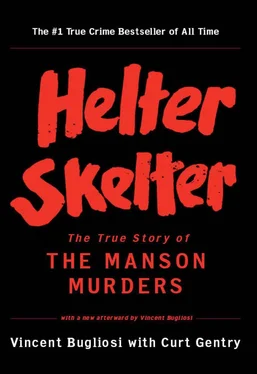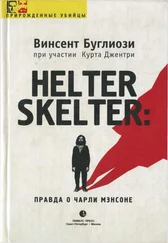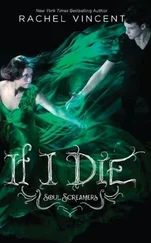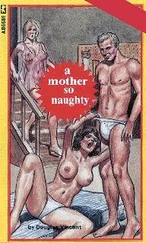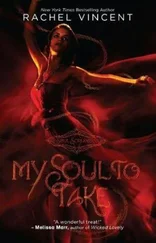The accounts that day and the next were notable for the unusual amount of detail they contained. So much information had been given out, in fact, that the detectives would have difficulty finding “polygraph keys” for questioning suspects.
In any homicide, it is standard practice to withhold certain information which presumably only the police and the killer(s) know. If a suspect confesses, or agrees to a polygraph examination, these keys can then be used to determine if he is telling the truth.
Owing to the many leaks, the detectives assigned to the “Tate case,” as the press was already calling the murders, could only come up with five: (1) That the knife used was probably a bayonet. (2) That the gun was probably a .22 caliber revolver. (3) The exact dimensions of the rope, as well as the way it was looped and tied. And (4) and (5), that a pair of horn-rimmed glasses and a Buck knife had been found.
The amount of information unofficially released so bothered LAPD brass that a tight lid was clamped on further disclosures. This didn’t please the reporters; also, lacking hard news, many turned to conjecture and speculation. In the days that followed a monumental amount of false information was published. It was widely reported, for example, that Sharon Tate’s unborn child had been ripped from her womb; that one or both of her breasts had been slashed off; that several of the victims had been sexually mutilated. The towel over Sebring’s face became a white hood (KKK?) or a black hood (satanists?), depending on which paper or magazine you read.
When it came to the man charged with the murders, however, there was a paucity of information. It was presumed, initially, that the police were maintaining silence to protect Garretson’s rights. It was also presumed that LAPD had to have a strong case against him or they wouldn’t have arrested him.
A Pasadena paper, picking up bits and pieces of information, sought to fill the gap. It stated that when the officers found Garretson, he asked, “When are the detectives going to see me?” The implication was obvious: Garretson knew what had happened. Garretson did ask this, but it was as he was being taken through the gate, long after his arrest, and the question was in response to an earlier comment by DeRosa. Quoting unidentified policemen, the paper also noted: “They said the slender youth had a rip in one knee of his pants and his living quarters in the guest cottage showed signs of a struggle.” Damning evidence, unless one were aware that all this happened during, not before, Garretson’s arrest.
During the first few days a total of forty-three officers would visit the crime scene, looking for weapons and other evidence. In searching the loft above the living room, Sergeant Mike McGann found a film can containing a roll of video-tape. Sergeant Ed Henderson took it to the Police Academy, which had screening facilities. The film showed Sharon and Roman Polanski making love. With a certain delicacy, the tape was not booked into evidence but was returned to the loft where it had been found. [5] One writer would later claim that the police found a vast collection of pornography in the residence, including numerous films and still shots of famous Hollywood stars engaged in various sexual acts. Aside from the above, and several unexposed rolls of videotape, the only photographs found anywhere on the property were a set of wedding pictures and a large number of publicity shots of Sharon Tate. The same writer also claimed that a number of black hoods were found in the loft. Apparently he created them out of the same material as his photos, for nothing even resembling a hood was found.
In addition to searching the premises, detectives interviewed neighbors, asking if they had seen any strange people in the area.
Ray Asin recalled that two or three months before there had been a large party at 10050 Cielo Drive, the guests arriving in “hippie garb.” He got the impression, however, that they weren’t actually hippies, as most arrived in Rolls-Royces and Cadillacs.
Emmett Steele, who had been awakened by the barking of his hunting dogs the previous night, remembered that in recent weeks someone had been racing a dune buggy up and down the hills late at night, but he never got a close look at the driver and passengers.
Most of those interviewed, however, claimed they had neither seen nor heard anything out of the ordinary.
The detectives were left with far more questions than answers. However, they were hopeful one person could put the puzzle together for them: William Garretson.
The detectives downtown were less optimistic. Following his arrest, the nineteen-year-old had been taken to West Los Angeles jail and interrogated. The officers found his answers “stuporous and non-responsive,” and were of the opinion that he was under the residual effect of some drug. It was also possible, as Garretson himself claimed, that he had slept little the previous night, just a few hours in the morning, and that he was exhausted, and very scared.
Shortly after this, Garretson retained the services of attorney Barry Tarlow. A second interview, with Tarlow present, took place at Parker Center, headquarters of the Los Angeles Police Department. As far as the police were concerned, it too was unproductive. Garretson claimed that although he lived on the property, he had little contact with the people in the main house. He said that he’d only had one visitor the previous night, a boy named Steve Parent, who showed up about 11:45 and left about a half hour later. Questioned about Parent, Garretson said he didn’t know him well. He’d hitched a ride up the canyon with him one night a couple of weeks ago and, on getting out of the car at the gate, had told Steve if he was ever in the neighborhood to drop in. Garretson, who lived by himself in the back house, except for the dogs, said he’d extended similar invitations to others. When Steve showed up, he was surprised: no one else ever had. But Steve didn’t stay long, leaving after learning that Garretson wasn’t interested in buying a clock radio Steve had for sale.
The police did not at this time connect Garretson’s visitor with the youth in the Rambler, possibly because Garretson had earlier failed to identify him.
After conferring with Tarlow, Garretson agreed to take a polygraph examination, and one was scheduled for the following afternoon.
Twelve hours had passed since the discovery of the bodies. John Doe 85 remained unidentified.
Police lieutenant Robert Madlock, who had been in charge of the investigation during the several hours before it was assigned to homicide, would later state: “At the time we first found the [victim’s] car at the scene, we were going fourteen different directions at once. So many things had to be done, I guess we just didn’t have time to follow up on the car registration.”
All day Wilfred and Juanita Parent had waited, and worried. Their eighteen-year-old son Steven hadn’t come home the previous night. “He didn’t call, didn’t leave word. He’d never done anything like that before,” Juanita Parent said.
About 8 P.M., aware that his wife was too distraught to cook dinner, Wilfred Parent took her and their three other children to a restaurant. Maybe when we get back, he told his wife, Steve will be there.
From outside the gate of 10050 Cielo it was possible to make out the license number on the white Rambler: ZLR 694. A reporter wrote it down, then ran his own check through the Department of Motor Vehicles, learning that the registered owner was “Wilfred E. or Juanita D. Parent, 11214 Bryant Drive, El Monte, California.”
By the time he arrived in El Monte, a Los Angeles suburb some twenty-five miles from Cielo Drive, he found no one at home. Questioning the neighbors, he learned that the family did have a boy in his late teens; he also learned the name of the family priest, Father Robert Byrne, of the Church of the Nativity, and called on him. Byrne knew the youth and his family well. Though the priest was sure Steve didn’t know any movie stars and that all this was some mistake, he agreed to accompany the reporter to the county morgue. On the way he talked about Steve. He was a stereo “bug,” Father Byrne said; if you ever wanted to know anything about phonographs or radios, Steve had the answers. Father Byrne held great hopes for his future.
Читать дальше
